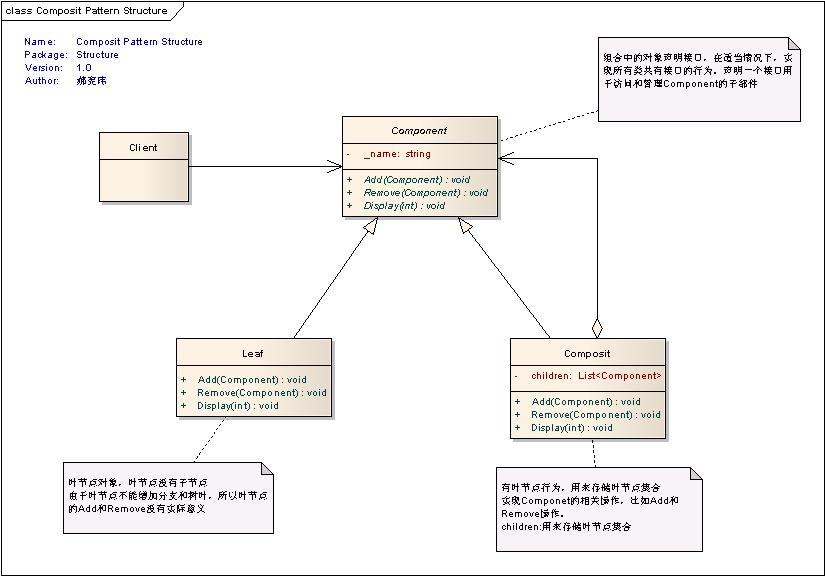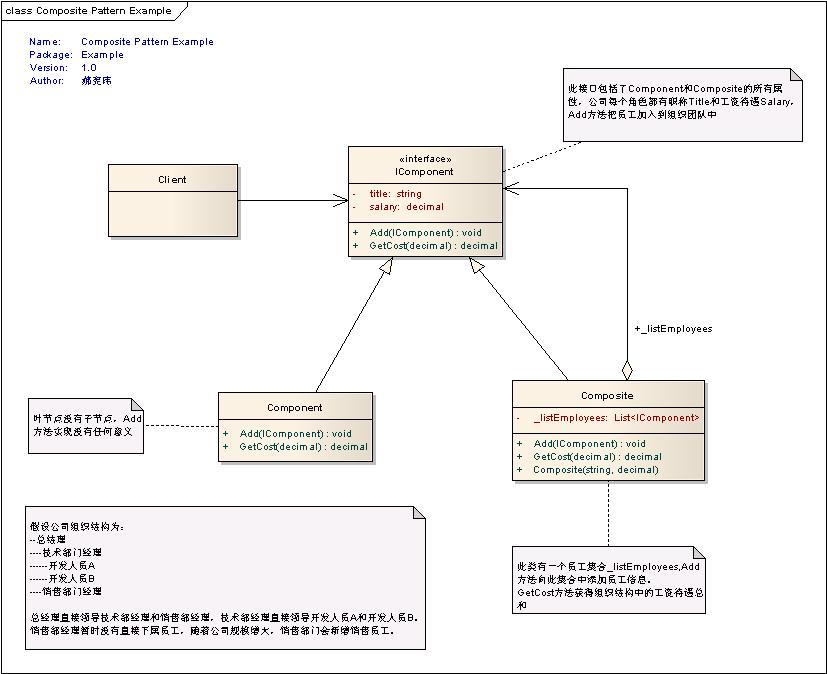一、组合模式简介(Brief Introduction)
组合模式,将对象组合成树形结构以表示“部分-整体”的层次结构,组合模式使得用户对单个对象和组合对象的使用具有一致性。
二、解决的问题(What To Solve)
解决整合与部分可以被一致对待问题。
三、组合模式分析(Analysis)
1、组合模式结构

Component类:组合中的对象声明接口,在适当情况下,实现所有类共有接口的行为。声明一个接口用于访问和管理Component的子部件
Leaf类:叶节点对象,叶节点没有子节点。由于叶节点不能增加分支和树叶,所以叶节点的Add和Remove没有实际意义。
有叶节点行为,用来存储叶节点集合
Composite类:实现Componet的相关操作,比如Add和Remove操作。
children:用来存储叶节点集合
2、源代码
| 1、抽象类Component |
| public abstract class Component { protected string name;
public Component(string name) { this.name = name; }
public abstract void Add(Component c); public abstract void Remove(Component c); public abstract void Diaplay(int depth); } |
| 2、叶子节点Leaf 继承于Component |
| public class Leaf:Component {
public Leaf(string name) :base(name) {
}
public override void Add(Component c) { Console.WriteLine("不能向叶子节点添加子节点"); }
public override void Remove(Component c) { Console.WriteLine("叶子节点没有子节点"); }
public override void Diaplay(int depth) { Console.WriteLine(new string('-',depth)+name); } } |
| 3、组合类Composite继承于Component,拥有枝节点行为 |
| public class Composite : Component {
List<Component> children;
public Composite(string name) :base(name) { if (children == null) { children = new List<Component>(); } }
public override void Add(Component c) { this.children.Add(c); }
public override void Remove(Component c) { this.children.Remove(c); }
public override void Diaplay(int depth) { Console.WriteLine(new String('-',depth)+name); foreach (Component component in children) { component.Diaplay(depth + 2); } } }
|
| 4、客户端代码 |
| static void Main(string[] args) { Composite root = new Composite("根节点root"); root.Add(new Leaf("根上生出的叶子A")); root.Add(new Leaf("根上生出的叶子B"));
Composite comp = new Composite("根上生出的分支CompositeX"); comp.Add(new Leaf("分支CompositeX生出的叶子LeafXA")); comp.Add(new Leaf("分支CompositeX生出的叶子LeafXB"));
root.Add(comp);
Composite comp2 = new Composite("分支CompositeX生出的分支CompositeXY"); comp2.Add(new Leaf("分支CompositeXY生出叶子LeafXYA")); comp2.Add(new Leaf("分支CompositeXY生出叶子LeafXYB"));
comp.Add(comp2);
root.Add(new Leaf("根节点生成的叶子LeafC")); Leaf leafD = new Leaf("leaf D"); root.Add(leafD); root.Remove(leafD); root.Diaplay(1); Console.Read(); } |
3、程序运行结果

四.案例分析(Example)
1、场景
假设公司组织结构为:
--总结理
----技术部门经理
------开发人员A
------开发人员B
----销售部门经理
总经理直接领导技术部经理和销售部经理,技术部经理直接领导开发人员A和开发人员B。销售部经理暂时没有直接下属员工,随着公司规模增大,销售部门会新增销售员工。计算组织结构的总工资状况。
如下图所示
IComponent接口:此接口包括了Component和Composite的所有属性,公司每个角色都有职称Title和工资待遇Salary,Add方法把员工加入到组织团队中。
Component叶子节点:叶节点没有子节点,Add方法实现没有任何意义。
Composite组合类:此类有一个员工集合_listEmployees,Add方法向此集合中添加员工信息。
GetCost方法获得组织结构中的工资待遇总和
2、代码
| 1、接口IComponent |
8. |
| 2、叶节点Component |
22.
|
| 3、组合类Composite |
| 1. public class Composite : IComponent 2. { 3. private List<IComponent> _listEmployees; 4. 5. public string Title { get; set; } 6. public decimal Salary { get; set; } 7. 8. public Composite(string Title, decimal Salary) 9. { 10. this.Title = Title; 11. this.Salary = Salary; 12. _listEmployees = new List<IComponent>(); 13. } 14. 15. public void Add(IComponent comp) 16. { 17. _listEmployees.Add(comp); 18. } 19. 20. public void GetCost(ref decimal salary) 21. { 22. salary += this.Salary; 23. 24. foreach (IComponent component in this._listEmployees) 25. { 26. component.GetCost(ref salary); 27. } 28. } 29. } |
| 4、客户端代码 |
33. |
五、总结(Summary)
组合模式,将对象组合成树形结构以表示“部分-整体”的层次结构,组合模式使得用户对单个对象和组合对象的使用具有一致性。解决整合与部分可以被一致对待问题
最后
以上就是微笑小甜瓜最近收集整理的关于组合模式-Component的全部内容,更多相关组合模式-Component内容请搜索靠谱客的其他文章。









发表评论 取消回复